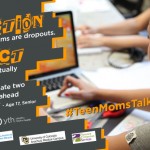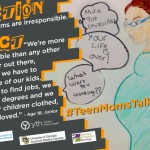The average American loses his or her virginity at age 17, during a stage of life that is marked by fluctuations in hormones that change our bodies, emotions and perceptions of ourselves. It can be a confusing time for many teens as they explore many new feelings in their changing bodies. While most receive some form of sexual and reproductive health education at school, it is unclear how that education, and the education teens receive elsewhere, play out in their real sex lives. Are they getting sexual health care? Are they practicing safe sex, and if not, do they want to? The answers to these questions are crucial for informing the development of better sexual and reproductive health education and monitoring the effectiveness of the current education that US youth receive.
Funded by the Ford Foundation, the Latino Research and Policy Center at the University of Colorado partnered with YTH and Florence Crittenton Services to conduct a cross-sectional survey of 14-24 year olds in the Denver Metropolitan area on sexual and reproductive health awareness, attitudes and risk behaviors. Parenting or pregnant youth (12.6% of total sample) participated in the study as well as non-parenting and never pregnant youth. All surveyed are of a similar socio-eonomic background as the teen mothers involved in the #TeenMomsTalkBack campaign, which you can find here.
Less than Half Sexually Active
The median age of the study was 17 years old, and 47% of participants reported being sexually active. This is reflective of national averages – the average age of sexual debut is 17.
Over Half Use Contraception
Out of those who were sexually active, 60% used contraception, chiefly condoms. Seven per cent of the sexually active teens used non-condom birth control. This is also almost exactly reflective of the national average of high schoolers’ use of contraception: 40.9% of high schoolers practice unsafe sex.
Most Sexually Active Teens Use Health Care Services
Out of the 91 sexually active youth interviewed, 73, or 80% sought health care. Only one third of these, however, had tested for HIV.
Higher Social Capital Reduces Risk Taking
Higher levels of social capital, defined as being engaged as a volunteer in one’s community, and perceiving support from adults and members of the community, are directly associated with greater effectiveness of communication about sex, and youth being more empowered to refuse sex. This is also linked to less drunk sex, and fewer sex partners in the past 90 days.
Men More Likely to be Intoxicated During Sex
Just over half of sexually active men surveyed had ever been drunk or high during sex, compared with only 6% of sexually active women.
Young Parents More Likely to Be Arrested or Jailed
Sixteen per cent of parenting or pregnant youth had been jailed and the same amount arrested, compared with only 3% of the whole sample.
Young Parents More Likely to Fail a Course in School
Two fifths (41%) of parenting or pregnant youth had ever failed a course, compared with 15% from the whole sample.
Young Parents Appeared to Face No Extra Risk of Suspension
Only six of the surveyed 199 youth had ever been suspended from school, and none of those were pregnant or parenting youth.
What does it all mean?
These results show that the community surveyed displays sexual habits very similar to the US at large – thus the teen parents likely have similar sex ed and social inputs to other US teens. However, in this small sample, teen parents were more likely to encounter law enforcement and more likely to fail a course in school than their non-parenting counterparts. It is important to keep in mind that because these are data from a single cross-section of Denver youth, it is not possible to positively identify the correlation between these factors.
Youth who felt more invested in and supported by their community showed healthier sexual habits and less risk taking. One important question should be how to help young people feel more engaged in their community.
Teens who were sexually active were more likely to use health care services but uptake of HIV testing is still very low, with only 33% of sexually active teens ever having been tested even though 80% of them used health care services. Are health care providers informing teens about and encouraging HIV and STI testing when providing them with other health services? Since the majority of sexually active young people are accessing health care, clinics and health centers could be key players in increasing STI testing habits amongst this population.
tags: HIV testing, HIV/AIDS, reproductive health, sexual health, teenmomstalkback.
Previous Post
AIDSinfo Releases HIV Drug App


